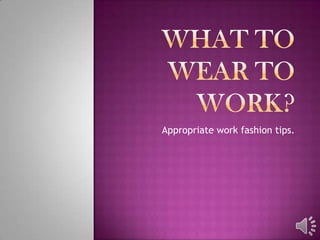What to wear to work
- 1. Appropriate work fashion tips.
- 2. When you are getting dressed for work, it is a lot different than when you are getting ready to go out with some friends or going on a date. The goal of dressing to work is to blend in with every one else. It’s not so much about your personal style as it is about representing your company in a positive way. So how can you tell ahead of time what the rest of the workplace will be wearing? Simple, think about your interview. How was the interviewer dressed? How was the working environment? Did you notice how the rest of the employees were dressed? If so, use that information to get dressed to the same level of formality whether you are male of female.
- 3. Business casual Industrial-construction Casual dress Business formal Formal-professional Customer interaction and trade show
- 4. All casual clothing is not appropriate for the work place. These guidelines will help you determine what is appropriate to wear to work. Slacks, pants and suit pants Slacks that are similar to Dockers and other makers of cotton or synthetic material pants, wool pants, flannel pants, dressy capris, and nice looking dress synthetic pants are acceptable. Skirts, dresses and Skirted suits Casual dresses and skirts, and skirts that are split at or below the knee are acceptable. Dress and skirt length should be at a length at which you can sit comfortably in public. Cont’d…
- 5. Shirts, tops, blouses and jackets Casual shirts, dress shirts, sweaters, tops, golf- type shirts, and turtlenecks are acceptable attire for work. Most suit jackets or sport jackets are also acceptable attire for the office, if they violate none of the listed guidelines. Shoes and footwear Conservative athletic or walking shoes, loafers, clogs, sneakers, boots, flats, dress heels, and leather deck-type shoes are acceptable for work. Wearing no stockings is acceptable in warm weather. Jewelry, makeup, perfume and cologne Should be in good taste, with limited visible body piercing. Remember, that some employees are allergic to the chemicals in perfumes and make-up, so wear these substances with restraint.
- 6. Slacks, pants and suit pants Jeans, sweatpants, exercise pants, Bermuda shorts, short shorts, shorts, bib overalls, leggings, and any spandex or other form-fitting pants such as people wear for biking. Skirts, dresses and skirted suits Short, tight skirts that ride halfway up the thigh, Mini- skirts, skorts, sun dresses, beach dresses, and spaghetti-strap dresses are inappropriate for work. Shirts, tops, blouses and Jackets Inappropriate attire for work includes tank tops; midriff tops; shirts with potentially offensive words, terms, logos, pictures, cartoons, or slogans; halter- tops; tops with bare shoulders; sweatshirts, and t-shirts unless worn under another blouse, shirt, jacket, or dress. cont’d….
- 7. Shoes and footwear Flashy athletic shoes, thongs, flip-flops, slippers, and any shoe with an open toe are not acceptable in the office. Closed toe and closed heel shoes are required in the manufacturing operation area. Jewelry makeup, perfume and cologne Wear with restraint. Hats and head coverings Hats are not appropriate in the office. Head Covers that are required for religious purposes or to honor cultural tradition are allowed.
- 11. This is a general overview of appropriate business casual attire. Items that are not appropriate for the office are listed, too. Neither list is all- inclusive and both are open to change. The lists tell you what is generally acceptable as business casual attire and what is generally not acceptable as business casual attire. Business casual is the most acceptable and widely accepted form of work attire. To sum it up, here are a few more hints… Clothing that works well for the beach, yard work, dance clubs, exercise sessions, and sports contests may not be appropriate for a professional appearance at work. Clothing that reveals too much cleavage, your back, your chest, your feet, your stomach or your underwear is not appropriate for a place of business, even in a business casual setting. Even in a business casual work environment, clothing should be pressed and never wrinkled. Torn, dirty, or frayed clothing is unacceptable. All seams must be finished. Any clothing that has words, terms, or pictures that may be offensive to other employees is unacceptable. Clothing that has the company logo is encouraged. Sports team, university, and fashion brand names on clothing are generally acceptable.
